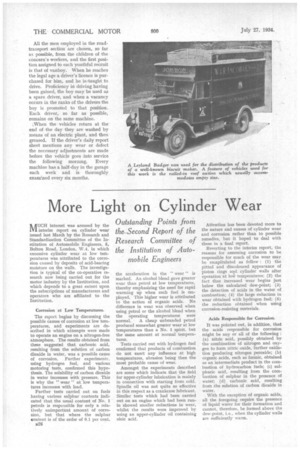More Light on Cylinder Wear
Page 46

If you've noticed an error in this article please click here to report it so we can fix it.
NRUCH interest was aroused by the Wi interim report on cylinder wear issued last March by the Research and Standardization Committee of the Institution of Automobile Engineers, 5, Bolton Road, London, W.4, in which excessive cylinder wear at low temperatures was attributed to the corrosion caused by deposits of acid-bearing moisture on the walls. The investigation is typical of the co-operative research now being carried out for the motor industry by the Institution, and which depends to a great extent upon the subscriptions of manufacturers and operators who are affiliated to the Institution.
Corrosion at Low Temperatures.
The report begins by discussing the possible causes of corrosion at low temperatures, and experiments are described in which attempts were made to operate an engine on a nitrogen-free atmosphere. The results obtained from these suggested that carbonic acid, resulting from the solution of carbon dioxide in water, was a possible cause of corrosion. Further experiment:, using hydrogen fuel, and various motoring tests, confirmed this hypothesis. The solubility of carbon dioxide in water increases with pressure. This is why the " wear " at low temperatures increases with load.
Further tests carried out on fuels having various sulphur contents indicated that the usual content of No. 1 petrols is responsible for only a relatively unimportant amount of corrosion, but that where the sulphur content is of the order of 0.1 per cent.
B2S
the acceleration in the " wear " is marked. An alcohol blend gave greater wear than petrol at low temperatures, thereby emphasizing the need for rapid warming up when such fuel is employed. This higher wear is attributed to the action of organic acids. No difference in wear was observed when using petrol or the alcohol blend when the operating temperatures were normal. A cheap unbranded petrol produced somewhat greater wear at low temperatures than a No. 1 spirit, but the same amount at normal temperatures.
Tests carried out with hydrogen fuel confirmed that products of combustion do not exert any influence at high temperatures, abrasion being then the most probable cause of wear.
Amongst the experiments described are some which indicate that the field for upper-cylinder lubrication is mainly in connection with starting from cold. Spindle oil was not quite so effective in this respect as a crankcase lubricant. Similar tests which had been carried out on an engine which had been runin showed smaller reductions in wear, whilst the results were improved by using an upper-cylinder oil containing oleic acid. Attention has been devoted more to the nature and causes of cylinder wear and corrosion rather than to possible remedies, but it hoped to deal with these in a final report.
Reverting to the interim report, the reasons for assuming corrosion to be responsible for much of the wear may be recapitulated as follow : (1) the pitted and discoloured appearance of piston rings and cylinder walls after operation at low temperatures; (2) the fact that increased wear begins just below the calculated dew-point; (3) the detection of acids in the water of combustion; (4) the large reduction in wear obtained with hydrogen fuel; (5) the reduction obtained when using corrosion-resisting materials.
Acids Responsible for Corrosion.
It was pointed out, in addition, that the acids responsible for corrosion might be any or all of the following : (a) nitric acid, possibly obtained by the combination of nitrogen and oxygen to form nitric oxide, further oxidation producing nitrogen peroxide; (b) organic acids, such as formic, obtained as an intermediate product in the combustion of hydrocarbon fuels; (c) sulphuric acid, resulting from the combustion of sulphur in the presence of water; (d) carbonic acid, resulting from the solution of carbon dioxide in water.
With the exception of organic acids, all the foregoing require the presence of liquid water for their formation and cannot, therefore, be formed above the dew-point, i.e., when the cylinder walls are sufficiently warm.




































































































